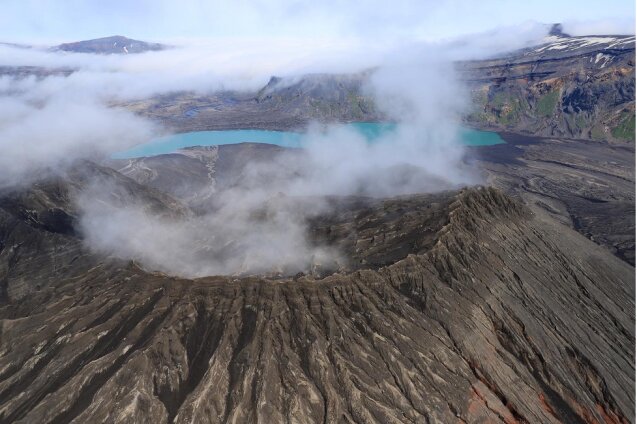
When attending conferences, it is often possible to look at groups of scientists and guess what their specialty might be. The astronomers are more likely to be in suits or at least in business shirts and slacks. Theorists have that pale color and attire normally associated with computer folks. And geologists often look ever ready to go off into the mountains and have the tans of people not afraid of daylight.
In the midst of all these groups are the often fit and fearless volcanologists. They are like the Indiana Jones of geologic data, and the insane lengths they go to often go unacknowledged. One graduate student, however, may change all that.
Columbia Climate School Ph.D. candidate Jasper Baur is sharing out his experience trying to uncover the secrets of Alaska’s volcanos. In an online essay, he writes from the Steadfast, a 108-foot crabber turned research ship, that: …this is my first time in Alaska. It is also my first time living on a research vessel, flying in helicopters, riding an ATV, eating fresh halibut caught that very afternoon, and being chased by a herd of bulls. While all of these firsts are stories unto themselves, on July 15th, I entered my first caldera at Okmok Volcano on Umnak Island located approximately 4,200 miles away from New York in the Aleutian Island volcanic chain.
In an article we’ll link to from DailySpace.org, Jasper describes how he explored the six-mile across Okmok Caldera, on foot, to collect samples of the carbon dioxide it was emitting.
I am totally a volcano stan, but I would not want to enter the volcano that may be responsible for the collapse of the Roman Republic without Star Trek-style transporter technology to zap me out as needed. In 43 BCE, Okmok had a massive eruption that may have both created that six-mile across crater rim and released so much material into the Earth’s atmosphere that it caused a volcanic winter that triggered crop failures and subsequent famine and related disease. While it hasn’t had that scale of an eruption in the past 2000-ish years, it is still active, and in 2008 built up a massive ash cone named Ahmanilix.
From inside this crater, Jasper was able to not only collect gases but also study how erosive processes have carved that young ash cone to appear to be covered in veins of cracks, such as we’re more used to seeing eroded over thousands of years into sandstone rocks and other geologic features. These nature-made designs demonstrate how the stuff of volcanoes is rapidly worn by the forces of rain, wind, and snow.
By understanding how the appearances of volcanoes evolve, we can understand how their outgassing changes and how everything shifts and tilts and erodes, and grows all at the same time inside these deadly environments. This is multivariable science set to survival level difficulty, but if researchers like Jasper can tease apart all these factors, maybe, just maybe, they’ll be able to piece together predictive models that will help us understand when volcanoes may be gearing up to erupt.
It’s dangerous work, and I’m amazed at the physical and mental stamina this work requires. I look forward to watching Jasper’s work from the comfort of my desk, and I can only hope that I, in my astronomer’s suit jacket, will one day meet him at a conference.
More Information
BLOG: A Journey Into an Alaskan Volcano (Columbia Climate School)




 Join the Crew!
Join the Crew!
 Escape Velocity Space News
Escape Velocity Space News
0 Comments